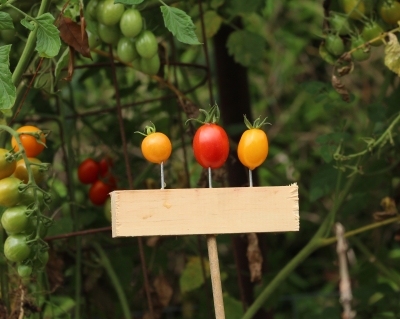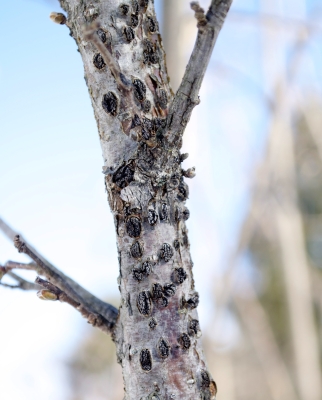ON TRIAL
And the Best Cherry Tomato Is . . .
Take your picks from the descriptor grab bag: Honey, Gold, Drop, Sun, Bunch, etc. Now put a couple of them together and you might end up with a luscious-sounding name for a tomato variety. People have done this, and reeled me right in. This year I got fished into planting a few, new (for me) varieties of cherry tomato.
Sungold is the gold standard of cherry tomatoes, the one I always grow. Its rich aroma underlies a sweetness livened with just the right amount of tang. One problem with Sungold is that it’s an F-1 hybrid, which means that you can’t save the seed and expect the resulting seedlings’ fruits to have the flavor of Sungold. The flavor might be better, but it’s more likely to be not as good. The other problem with Sungold is that the seeds, which must be purchased, are expensive.
The first of this year’s lineup was the variety Solid Gold, a yellow, teardrop shaped tomato. Like Sungold, it’s an F-1 hybrid. Perhaps it would offer better or different, but also excellent, eating. It has been billed as having “outstanding flavor of true grape tomatoes” (by those selling the seeds). Grape tomatoes are tiny tomatoes, a different species from other tomatoes, with very good, very sweet flavor.
Honeybunch, the second in the lineup, is another F-1 hybrid, this one red and teardrop shaped. “As if a pearl tomato(?) had been drizzled with honey,” so they say.
The flavor of another variety, Honey Drop, was likened to that of honeydew melon. This one’s a Sungold look-alike and is open-pollinated, so seedlings should generally yield the same fruits as the parent.
All three of these new varieties have borne early, and their stems have been heavy all season long with beautiful golden or red fruits. One reason their stems are so laden with fruits is because we don’t pick them. Not when we also have Sungold tomatoes to munch on. Solid Gold, Honey Bunch, Honey Drop, and the unnamed variety are all very good tomatoes, but why eat a very good tomato when you can eat the best tomato?
Filbert Plague, How Bad?
Moving out into the field, literally, to my filbert (hazel) nut bushes . . . East of the Rocky Mountains, most people who plant filberts, and especially permaculturalists, plant American filberts (Corylus americana). This species is resistant to eastern filbert blight, a fungal disease endemic in these parts. I once grew American filberts, and they are beautiful in fall when their leaves turn blazing shades of red. Unfortunately, their nuts are small, with bad flavor — a good wildlife food, a poor human food.
European filberts (C. avellana), and various hybrids, are what yield the large and tasty nuts of commerce. Orchards of these filberts are mostly in the Pacific Northwest. About 50 years ago, Eastern filbert blight made inroads to those orchards, which prompted breeding programs for blight-resistant varieties.
I’ve planted a number of blight resistant filbert varieties, including some older varieties bred decades ago in the East. As it turns out, though, the the blight fungus exists in more than one regional strain; like some other fungi, the blight fungus might also morph over time.
Join me as I walk my row of filberts and note the performance of the various varieties. Four of the plants are only in their second year and are from the New Jersey breeding program of Tom Molnar, at Rutgers. The hope is that they’ll be more blight resistant than the western-bred varieties.
The worst of the older plants include the varieties Clark, Eta, and Hall’s Giant. Clark and Eta are western-bred, while Hall’s Giant is an older, easter-bred variety that is bearing a moderate number of good-sized nuts in spite of the blight.
Santiam, from the west, is afflicted with a moderate amount of blight. The nuts it bears are small but still much larger and tastier than native American filberts.
Least blight-infected are the western varieties Lewis and Yamhill, the Italian variety Tonda di Giffoni, and Graham, an older, eastern variety. Thus far, my favorite is probably Graham, a hybrid of American and European filberts bred by Samuel H. Graham of Ithaca, New York, and introduced in 1950. It yields the largest nuts of the lot and shows its American parentage in its wide suckering growth habit and the fiery red of its leaves in autumn.
Results May Vary
As they say in ads: “Your results may vary.” The above are my experiences. Filbert blight, like any disease, only thrives with suitable environment, a susceptible host, AND presence of pathogen. My farmden fulfills all three conditions, with varying host plant susceptibility. But I only am growing one plant of each variety; slightly different conditions might affect susceptibility of individual plants.
Now, about my cherry tomato experiences: Tomato flavor varies little with climate or growing conditions, so your results probably would NOT vary from mine. Except of course, that it’s surely a matter of taste when it comes to taste.




